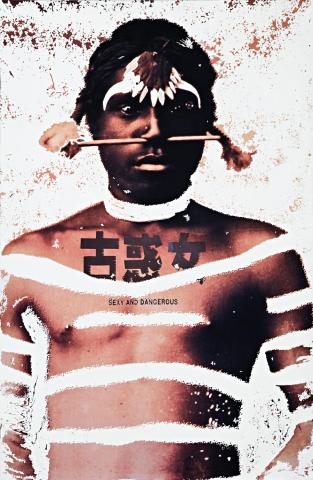SEXY AND DANGEROUS, 1996
Brook Andrew
digital image printed on duraclear, mounted on 6mm acrylic
145.0 x 95.0 cm
edition: artist's proof 2/2
Tolarno Galleries, Melbourne
Private collection, Melbourne
Barlow, G., Brook Andrew, Eye to Eye, Monash University Museum of Art, Victoria, 2007, p. 7 (illus. another example) Petitjean, G., Theme Park, Museum for Contemporary Aboriginal Art, The Netherlands, 2008, p. 71 (illus. another example)
Other examples of this edition are in the collections of the National Gallery of Australia, Canberra, the National Gallery of Victoria, Melbourne and the Queensland Art Gallery, Brisbane
Brook Andrew's multi-disciplinary practise encompasses photography, printmaking, painting and installation, as well as more recent incursions into the realms of architecture and the museum. His work is astoundingly lush whilst housing a fiercely intellectual and barbed interior. Operating from a space that is informed by both Australian and international concerns, Andrew's work asks us to consider the contours of history and power; the known and unknown, the coloniser and the colonised. As curator Max Delaney notes 'Deftly connecting aesthetics and polemics, Andrew creates striking and insightful works which neatly, beautifully, encapsulate complex conceptual and theoretical questions which emerge from lived experience.'1
In Sexy and Dangerous the manifold concerns which engage the artist converge. The historical image of the young indigenous man, liberated from its anthropological context, looms before us. His presence is political and poetic, evoking a moment distant in time and place, the world of an exotic, unspecified 'other'. Smothered by the romanticism of European sensibilities, in this elegant work Andrew releases an unknown Aboriginal man from the bounds of ethnographic curiosity and returns him to personhood.
As an image, however, Sexy and Dangerous is more than a memorial. There is a sense of sadness because we know the depicted figure is among the victims, the disappeared, yet the image is ultimately paradoxical. The subject's body is scored and effaced. He is a body marked by 'cultural interplay, memory and erasure - a figure written and rewritten by viewer's perceptions, apprehensions and misreadings.'2 Highlighting one of the central tenants of Andrews' practise, the artist himself describes the act of making art as a type of 'moveable social justice system; a system that condense and clarifies questions about morality, nationhood, personal expression, beliefs etc... So maybe it is a loop - a loop where artists address and imagine other possibilities.'3
1. Delaney, M., foreword in Barlow, G., Brook Andrew, Eye to Eye, Monash University Museum of Art, 2007, p. 5
2. Gardner, A., The Skin of Now: Contemporary Art, Contiguous Histories, in Brook Andrew, Theme Park, Museum for Contemporary Aboriginal Art, The Netherlands, 2008, p. 82
3. from a conversation between the artist and Maria Hlavajova, The Imagined Place Down Under, in Brook Andrew, Theme Park, Museum for Contemporary Aboriginal Art, The Netherlands, 2008, p. 22
